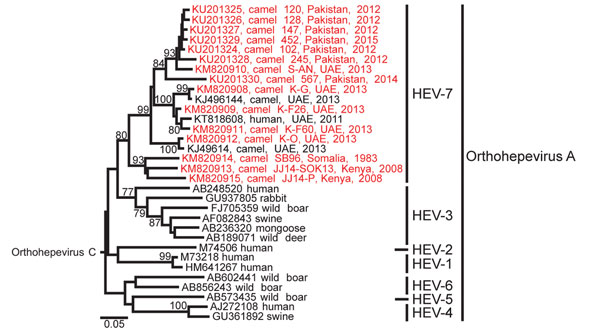Hepatitis E Virus Infection in Dromedaries, North and East Africa, United Arab Emirates, and Pakistan, 1983–2015
Andrea Rasche, Muhammad Saqib, Anne M. Liljander, Set Bornstein, Ali Zohaib, Stefanie Renneker, Katja Steinhagen, Renate Wernery, Mario Younan, Ilona Gluecks, Mosaad Hilali, Bakri E. Musa, Joerg Jores, Ulrich Wernery, Jan Felix Drexler, Christian Drosten

, and Victor Max Corman
Author affiliations: University of Bonn Medical Centre, Bonn, Germany (A. Rasche, J.F. Drexler, C. Drosten, V.M. Corman); University of Agriculture, Faisalabad, Pakistan (M. Saqib, A. Zohaib); International Livestock Research Institute, Nairobi, Kenya (A.M. Liljander, J. Jores); National Veterinary Institute, Uppsala, Sweden (S. Bornstein); EUROIMMUN AG, Lübeck, Germany (S. Renneker, K. Steinhagen); Central Veterinary Research Laboratory, Dubai, United Arab Emirates (R. Wernery, U. Wernery); Vétérinaires Sans Frontières Germany, Nairobi (M. Younan, I. Gluecks); Cairo University, Giza, Egypt (M. Hilali); Ministry of Science and Communication, Khartoum, Sudan (B.E. Musa); University of Bern, Bern, Switzerland (J. Jores); German Centre for Infection Research, Bonn (J.F. Drexler, C. Drosten, V.M. Corman)
Main Article
Figure 2

Figure 2. Phylogenetic analysis of Orthohepevirus A sequences. The analysis comprised partial hepatitis E virus (HEV) sequences (283 nt from the RNA-dependent RNA polymerase region) from this study, representatives of Orthohepevirus A genotypes 1–7 and Orthohepevirus C (GenBank accession no. GU345042) as an outgroup. The phylogenetic tree was calculated with MEGA 6.0 (http://www.megasoftware.net) by using the neighbor-joining algorithm and a nucleotide percentage distance substitution model. Bootstrap values (%) of 1,000 repetitive analyses >75 are shown next to the nodes. New camel HEV sequences obtained in this study are in red. Scale bar represents the genetic distance. All sequences obtained in this study are deposited in GenBank (accession nos. KM820907–KM820915 and KU201324–KU201330). UAE, United Arab Emirates.
Main Article
Page created: March 16, 2017
Page updated: March 16, 2017
Page reviewed: March 16, 2017
The conclusions, findings, and opinions expressed by authors contributing to this journal do not necessarily reflect the official position of the U.S. Department of Health and Human Services, the Public Health Service, the Centers for Disease Control and Prevention, or the authors' affiliated institutions. Use of trade names is for identification only and does not imply endorsement by any of the groups named above.
